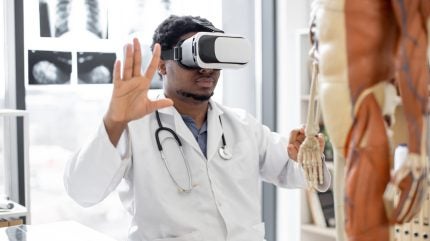
Virtual reality (VR) technology is transforming the medical field, according to a new report.
Specifically, GlobalData’s Virtual Reality in Medical report details that technology is bringing advancements that enhance training, prototyping and patient treatment. It explains: “By offering immersive, interactive and precise simulations, VR has become a valuable tool in medical and surgical training, medical device prototyping and testing and patient treatment and diagnostics.”
Medical training and simulation
The fundamental benefit of VR for medical training and simulation is that it allows medical students and professionals to interact with virtual patients and practice procedures in realistic and risk-free environments.
“VR provides realistic 3D simulations of the human body, enabling surgical trainees to practice intricate procedures repeatedly,” the report outlines. “This is especially beneficial in specialised fields such as neurosurgery, orthopedics and cardiovascular surgery, where precision is critical. Through haptic feedback, trainees can experience the sensation of cutting, suturing and manipulating tissues, improving their skills and confidence before performing actual surgeries. By practicing in a VR environment, medical professionals can refine their techniques, reducing the likelihood of errors in real-life situations.”
Indeed, the report notes studies have shown that surgeons trained with VR make fewer mistakes than those not trained using the technology and that they complete procedures more efficiently.
Medical device prototyping and testing
The benefit of VR for medical device development in that manufacturers can use the technology to visualise, prototype and test them before they are physically produced.
The report explains: “VR modelling allows designers to create virtual prototypes that can be adjusted in real-time, reducing the cost and time associated with traditional prototyping methods … By simulating various clinical scenarios, manufacturers can identify design flaws, assess performance and make necessary adjustments before physical production. This leads to more reliable and user-friendly medical devices, improving both healthcare outcomes and patient safety.”
The use of VR for modelling also allows for improved collaboration, the report notes. This is particularly beneficial given the various stakeholders involved, such as engineers, clinicians and regulatory experts. VR allows stakeholders to interact with virtual prototypes in real-time, regardless of their physical location.
“This accelerates decision-making, reduces miscommunication, and enhances the overall development process,” the report says. “Once a medical device is developed, healthcare professionals need to be trained on its proper use. VR provides an effective training platform where healthcare professionals can practice using new equipment in a simulated environment. This reduces the learning curve, enhances proficiency and ensures that medical devices are used safely and effectively in clinical settings.”
Patient treatment and diagnostics
The report adds that VR is increasingly being used in pain management and physical rehabilitation.
It says: “Patients with chronic pain, burn injuries, or undergoing physical therapy can use VR to distract their minds and engage in therapeutic exercises … VR has also proven effective in treating various mental health conditions, including post-traumatic stress disorder (PTSD), anxiety, and phobias.”
The technology can enhance diagnostic imaging, meanwhile, by converting traditional MRI and CT scans into 3D visualisations, which can be explored in an immersive environment. This allows doctors to analyse medical conditions and plan treatments more effectively. Exploring conditions with VR can benefit patients too, allowing them to better understand conditions.



